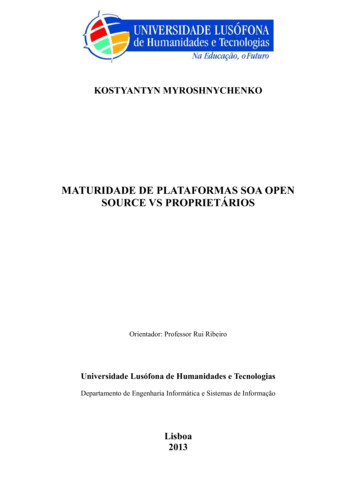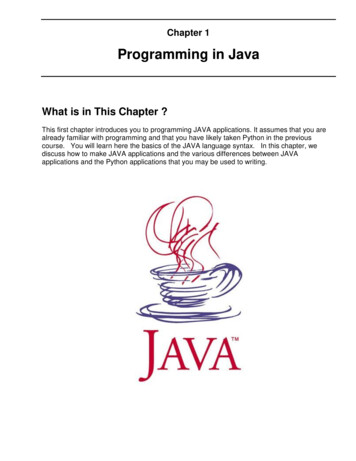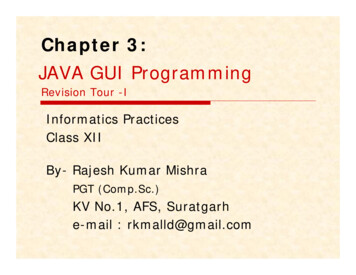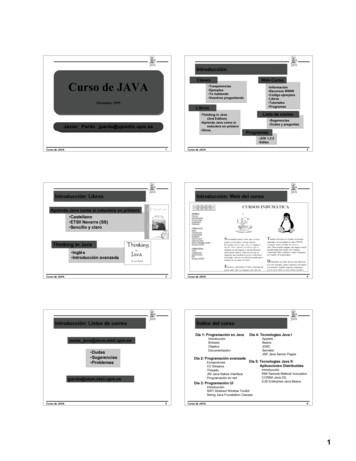
Transcription
The Java Memory Model:a Formal Explanation1M. Huisman2 G. Petri3INRIA Sophia Antipolis, FranceAbstractThis paper discusses the new Java Memory Model (JMM), introduced for Java 1.5. The JMM specifiesthe allowed executions of multithreaded Java programs. The new JMM fixes some security problems of theprevious memory model. In addition, it gives compiler builders the possibility to apply a wide range ofsinglethreaded compiler optimisations (something that was nearly impossible for the old memory model).For program developers, the JMM provides the following guarantee: if a program does not contain any dataraces, its allowed behaviours can be described with an interleaving semantics.This paper motivates the definition of the JMM. It shows in particular the consequences of the wish tohave the data race freeness guarantee and to forbid any out of thin air values to occur in an execution.The remainder of the paper then discusses a formalisation of the JMM in Coq. This formalisation hasbeen used to prove the data race freeness guarantee. Given the complexity of the JMM definition, havinga formalisation is necessary to investigate all aspects of the JMM.Keywords: Java Memory Model, formalisation, Data-Race-Freeness Guarantee1IntroductionWith the emergence of multiprocessor architectures, shared memory has shown tobe a simple and comfortable communication model for parallel programming thatis both intuitive for programmers, and close to the underlying machine model.However, the use of shared memory requires synchronisation mechanisms to keepthe memory of the overall system up-to-date and coherent. Such synchronisationmechanisms have a big impact on performance; to avoid these, several relaxations ofthe consistency (or coherence) of the memory system have been proposed [2,15,13].However, these relaxations might cause the program to have unexpected behaviours(from the programmer’s point of view). In general, the more relaxed the memorysystem, the harder it is to reason about the programs executing on it.1 This work is partially funded by the IST programme of the EC, under the IST-FET-2005-015905 Mobius project, and the French national research organisation (ANR), under the ANR-06-SETIN-010 ParSecproject.2 Email: Marieke.Huisman@inria.fr3 Email: Gustavo.Petri@inria.frc 2007Published by Elsevier Science B. V.
Huisman & PetriA memory model defines all the possible outcomes of a multithreaded programrunning on a shared memory architecture that implements it. In essence, it is aspecification of the possible values that read accesses on the memory are allowed toreturn 4 , and thus specifies the multithreaded semantics of the platform.Java is one of the few major programming languages with a precisely definedmemory model [19]. Java’s initial memory model allowed behaviours with securityleaks [21], and in addition, it prevented almost all singlethreaded compiler optimisations. Therefore, since Java 1.5, a new memory model has been introduced, thatfixes these defects. The Java Memory Model (JMM) has been designed with twogoals in mind: (i) as many compiler optimisations as possible should be allowed,and (ii) the average programmer should not have to understand all the intricacies ofthe model. To achieve the second goal, the JMM provides the following Data RaceFreeness (DRF) guarantee: if a program does not contain data races, its allowedbehaviours can be described by an interleaving semantics.To capture basic ordering and visibility requirements on memory operations,the JMM is based on the happens before order [16]. This order inspires the socalled happens before model, identifying the actions that necessarily have to happenbefore any other actions. In other words, this order specifies the updates on thememory that any read must see. Only executions that do not violate this orderare allowed. As the guarantees that this model provides are very weak, it allowsmany singlethreaded compiler optimisations. However, the happens before modelallows executions in which values are produced out of thin air 5 , by using circularjustifications of actions, as will be discussed in Section 2. To avoid such circularjustifications, and to guarantee DRF, the current version of the JMM is much morecomplex than the happens before model.Ample literature about the JMM and related models exists [19,18,22,6], butmost descriptions are very dense. In particular, the motivation of the justificationprocedure that defines legal executions is not extensively explained, i.e., it is unclearwhy it is defined as it is. This paper tries to overcome this problem by presentingour understanding of the JMM.In addition, it also presents a formalisation of the JMM in Coq [9]. Our formalisation proves that the DRF guarantee holds for the JMM (a hand-written prooffor this is given in [19], which contains some (minor) mistakes). As future work weplan to make a link with the Bicolano formalisation of the Java Virtual Machine(JVM) [20]. This motivates the use of Coq. We also plan to investigate otherproperties of the JMM formally, in particular the out-of-thin-air (OoTA) guarantee(however, this requires first to state formally what it means to avoid OoTA values).The rest of this paper is organised is follows. Section 2 explains and motivatesthe definition of the JMM. Next, Section 3 describes our formalisation. FinallySection 4 describes how we plan to use our JMM formalisation further.4We will in general—in conformance with memory model terminology—simply talk about “the write thata read sees”, instead of “the write that writes the value in the memory returned by the read”, as in generalwe do not care about the value, but only about the write action itself.5 A value that cannot be deduced from the program.2
Huisman & Petri2The Java Memory ModelThe JMM, as previously mentioned, has two main goals. The first goal is: to allowas many compiler optimisations as possible. This is limited by the second goal: tomake the task of multithreaded programming easier for the programmer. It is awell known fact that multithreaded programming is a hard task, and weak memorymodels further complicate this, in the sense that they add non-determinism to programs (caused by unexpected interleaving of actions). To achieve programmability,the approach of the JMM is that of data race free memory models [3,10,11]; i.e.,the DRF guarantee, which reads:Data Race Freeness: Correctly synchronised programs have sequentially consistent semantics.The notion of sequential consistency was first defined by Lamport [17]:“. the result of any execution is the same as if the operations of all the processorswere executed in some sequential order, and the operations of each individualprocessor appear in this sequence in the order specified by its program.”This definition has several consequences. First, the sequence of operations determines that there exists a total order which is consistent with the program order(the order dictated by the sequence of instructions in each thread), and where eachread of a memory location sees the last value written to that location. This impliesthat sequential consistent executions can be described by an interleaving semantics.Another important consequence is that the execution has to have a result as if itwas executed in a total order, but the actual order of the execution does not needto be total. Thus, compiler optimisations and parallel execution of instructions areallowed, provided that they can be serialised. This makes sequential consistencya very attractive model for concurrency. While sequential consistency has a clearsemantics, it is difficult for a compiler to determine statically whether it can ornot rearrange intructions or allow parallel execution of operations preserving sequentially consistent semantics. Therefore, many (but not all) common compileroptimisations for sequential code are prevented by this semantics. For that reason,weaker semantics are proposed for programs that are not correctly synchronised(i.e., that contain data races).A program is said to be correctly synchronised if its sequential consistent executions are free of data races. A data race occurs when two or more threadsconcurrently access a common memory location, where at least one of the accessesupdates the memory. Usually, the presence of data races is considered a bug inthe program. In general the result of such races cannot be predicted, thus the programmer must take care to avoid them. In addition, the architecture must provideguarantees to rule out data races. However, notice that sometimes data races areintended, so-called benign data races; even though programs with this kind of racesare not common.An important distinction between weak and strong models, is that the formerdistinguishes between normal memory operations and synchronisation operations,while the second does not. The basic idea is that synchronisation operations inducevisibility and ordering restrictions on the other operations in the execution. Fur3
Huisman & Petrithermore, synchronisation operations in Java are intended to have a sequentiallyconsistent semantics [19], i.e., there exists a total order of synchronisation operations, which is consistent with the program order, and where each synchronisationoperation is aware of all the previous synchronisation operations in that order. Thepresence of such a total order guarantees that all processors see synchronisationoperations in the same order (which is not the case for normal memory accesses).This order is called the synchronisation order (so). Lock and unlock operationson monitors and read and writes of volatile variables, are Java’s main synchronisation operations. The order of actions issued by single threads is called the programorder (po). Thus, po only relates actions of the same thread, while so can relatesynchronisation actions of different threads.The so relates synchronisation actions on different locations (either variablesor monitors). This is, in general, too restrictive to define which are the minimalvisibility conditions for actions. For example, read actions on different volatilevariables are necessarily related by so, since these are synchronisation actions andso is total, but these need not impose restrictions among the threads involved.Therefore a weaker order, derived from the so, is defined; namely the synchroniseswith order (sw). This is a per location restriction of the so, i.e., it only relates actionson the same location. The intuition of sw pairs is that they impose synchronisationof the memory between the intervening threads, in the sense that actions thathappen before a synchronised write need to be visible by any other thread that cansee that write via a volatile read that variable. The same intuition applies for unlockand lock actions. Thus, only unlock and volatile write actions appear in the sourceof a sw link while only volatile reads and unlock appear in the sink of the link.More precisely, sw links relate every volatile write with every subsequent (w.r.t. so)volatile read on the same variable, and every unlock with every subsequent (w.r.t.so) lock on the same monitor.The sw and the po orders allow us to define what constitutes a data race in theJMM, captured by the happens before (hb) order. The hb order is formally definedas the transitive closure of the union of the po and sw orders, i.e., it extends thedependency of the po between different threads through sw edges. We say thattwo normal actions are conflicting if they operate on the same memory locationand at least one of them is an update. An important note is that so and po mustbe consistent in JMM executions (i.e., synchronisation operations performed by asingle thread must appear in so in the same order as they appear in po). Thisguarantees that hb is a partial order. A more operational intuition of these ordersis that hb represents minimal visibility conditions, where sw links impose memorysynchronisations between threads, and the actions of a single thread are aware ofall previous actions (in po) by that thread. A data race in the JM
plan to make a link with the Bicolano formalisation of the Java Virtual Machine (JVM) [20]. This motivates the use of Coq. We also plan to investigate other properties of the JMM formally, in particular the out-of-thin-air (OoTA) guarantee (however, this requires first to state formally what it means to avoid OoTA values).











